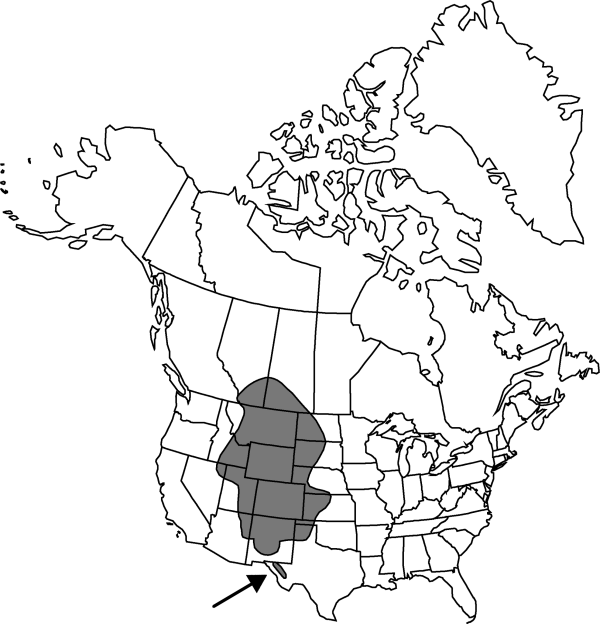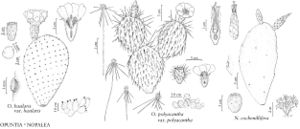Difference between revisions of "Opuntia polyacantha var. polyacantha"
FNA>Volume Importer |
imported>Volume Importer |
||
| (7 intermediate revisions by 2 users not shown) | |||
| Line 1: | Line 1: | ||
{{Treatment/ID | {{Treatment/ID | ||
|accepted_name=Opuntia polyacantha var. polyacantha | |accepted_name=Opuntia polyacantha var. polyacantha | ||
| − | |accepted_authority= | + | |accepted_authority= |
|publications= | |publications= | ||
| + | |special_status={{Treatment/ID/Special_status | ||
| + | |code=F | ||
| + | |label=Illustrated | ||
| + | }}{{Treatment/ID/Special_status | ||
| + | |code=E | ||
| + | |label=Endemic | ||
| + | }} | ||
|basionyms= | |basionyms= | ||
|synonyms={{Treatment/ID/Synonym | |synonyms={{Treatment/ID/Synonym | ||
|name=Opuntia heacockiae | |name=Opuntia heacockiae | ||
|authority=G. Arp | |authority=G. Arp | ||
| − | }}{{Treatment/ID/Synonym | + | |rank=species |
| + | }} {{Treatment/ID/Synonym | ||
|name=Opuntia juniper | |name=Opuntia juniper | ||
|authority=ina Britton & Rose | |authority=ina Britton & Rose | ||
| − | }}{{Treatment/ID/Synonym | + | |rank=species |
| + | }} {{Treatment/ID/Synonym | ||
|name=Opuntia polyacantha var. juniperina | |name=Opuntia polyacantha var. juniperina | ||
|authority=(Engelmann & J. M. Bigelow) L. D. Benson | |authority=(Engelmann & J. M. Bigelow) L. D. Benson | ||
| − | }}{{Treatment/ID/Synonym | + | |rank=variety |
| + | }} {{Treatment/ID/Synonym | ||
|name=Opuntia polyacantha var. rufispina | |name=Opuntia polyacantha var. rufispina | ||
|authority=(Engelmann) J. M. Coulter | |authority=(Engelmann) J. M. Coulter | ||
| − | }}{{Treatment/ID/Synonym | + | |rank=variety |
| + | }} {{Treatment/ID/Synonym | ||
|name=Opuntia polyacantha var. trichophora | |name=Opuntia polyacantha var. trichophora | ||
| − | |authority= | + | |authority= |
| − | }}{{Treatment/ID/Synonym | + | |rank=variety |
| + | }} {{Treatment/ID/Synonym | ||
|name=Opuntia trichophora | |name=Opuntia trichophora | ||
| − | |authority= | + | |authority= |
| + | |rank=species | ||
}} | }} | ||
|hierarchy=Cactaceae;Cactaceae subfam. Opuntioideae;Opuntia;Opuntia polyacantha;Opuntia polyacantha var. polyacantha | |hierarchy=Cactaceae;Cactaceae subfam. Opuntioideae;Opuntia;Opuntia polyacantha;Opuntia polyacantha var. polyacantha | ||
| Line 30: | Line 43: | ||
}}<!-- | }}<!-- | ||
| − | --><span class="statement" id="st- | + | --><span class="statement" id="st-undefined" data-properties=""><b>Stem </b>segments broadly obovate to circular, (4–)8.5–12 × (4–)5.5–11 cm; areoles 6–11 per diagonal row across midstem segment, 6–13 mm apart. <b>Spines</b> in most areoles, of 2 kinds: major spines (0–)1–3(–5) per areole, ± deflexed to reflexed or porrect at stem segment apex, yellow-brown to gray, 20–35(–40) mm; minor spines 0–5 per areole, deflexed, white, 5–10(–16) mm, sometimes spines of basal and near basal areoles are long, flexible, curling. <b>Fruits</b> stout; areoles 12–28, most bearing (4–)6–15 spines, 5–10 mm. <b>2n</b> = 22, 44.</span><!-- |
-->{{Treatment/Body | -->{{Treatment/Body | ||
| + | |phenology=Flowering late spring. | ||
|habitat=Grasslands, pinyon-juniper woodlands, clay, sandy or gravelly soils | |habitat=Grasslands, pinyon-juniper woodlands, clay, sandy or gravelly soils | ||
|elevation=500-2000(-2800) m | |elevation=500-2000(-2800) m | ||
|distribution=Alta.;Sask.;Ariz.;Colo.;Idaho;Kans.;Mont.;Nebr.;Nev.;N.Mex.;N.Dak.;Okla.;S.Dak.;Tex.;Utah;Wyo. | |distribution=Alta.;Sask.;Ariz.;Colo.;Idaho;Kans.;Mont.;Nebr.;Nev.;N.Mex.;N.Dak.;Okla.;S.Dak.;Tex.;Utah;Wyo. | ||
| − | |discussion=<p>The morphotype, usually called Opuntia trichophora, has additional, curly, hairlike spines from areoles on older stem segments, but these plants occur sporadically throughout the range of O. polyacantha var. polyacantha from New Mexico to Wyoming.</p> | + | |discussion=<p>The morphotype, usually called <i>Opuntia</i> trichophora, has additional, curly, hairlike spines from areoles on older stem segments, but these plants occur sporadically throughout the range of <i>O. polyacantha </i>var.<i> polyacantha</i> from New Mexico to Wyoming.</p> |
|tables= | |tables= | ||
|references= | |references= | ||
| Line 45: | Line 59: | ||
-->{{#Taxon: | -->{{#Taxon: | ||
name=Opuntia polyacantha var. polyacantha | name=Opuntia polyacantha var. polyacantha | ||
| − | + | |authority= | |
| − | |authority= | ||
|rank=variety | |rank=variety | ||
|parent rank=species | |parent rank=species | ||
| Line 52: | Line 65: | ||
|basionyms= | |basionyms= | ||
|family=Cactaceae | |family=Cactaceae | ||
| + | |phenology=Flowering late spring. | ||
|habitat=Grasslands, pinyon-juniper woodlands, clay, sandy or gravelly soils | |habitat=Grasslands, pinyon-juniper woodlands, clay, sandy or gravelly soils | ||
|elevation=500-2000(-2800) m | |elevation=500-2000(-2800) m | ||
| Line 58: | Line 72: | ||
|publication title= | |publication title= | ||
|publication year= | |publication year= | ||
| − | |special status= | + | |special status=Illustrated;Endemic |
| − | |source xml=https:// | + | |source xml=https://bitbucket.org/aafc-mbb/fna-data-curation/src/2e0870ddd59836b60bcf96646a41e87ea5a5943a/coarse_grained_fna_xml/V4/V4_284.xml |
|subfamily=Cactaceae subfam. Opuntioideae | |subfamily=Cactaceae subfam. Opuntioideae | ||
|genus=Opuntia | |genus=Opuntia | ||
|species=Opuntia polyacantha | |species=Opuntia polyacantha | ||
|variety=Opuntia polyacantha var. polyacantha | |variety=Opuntia polyacantha var. polyacantha | ||
| − | |||
| − | |||
| − | |||
| − | |||
| − | |||
| − | |||
| − | |||
| − | |||
| − | |||
| − | |||
| − | |||
| − | |||
| − | |||
| − | |||
| − | |||
| − | |||
| − | |||
| − | |||
| − | |||
| − | |||
| − | |||
| − | |||
| − | |||
| − | |||
| − | |||
| − | |||
}}<!-- | }}<!-- | ||
-->[[Category:Treatment]][[Category:Opuntia polyacantha]] | -->[[Category:Treatment]][[Category:Opuntia polyacantha]] | ||
Latest revision as of 21:57, 5 November 2020
Stem segments broadly obovate to circular, (4–)8.5–12 × (4–)5.5–11 cm; areoles 6–11 per diagonal row across midstem segment, 6–13 mm apart. Spines in most areoles, of 2 kinds: major spines (0–)1–3(–5) per areole, ± deflexed to reflexed or porrect at stem segment apex, yellow-brown to gray, 20–35(–40) mm; minor spines 0–5 per areole, deflexed, white, 5–10(–16) mm, sometimes spines of basal and near basal areoles are long, flexible, curling. Fruits stout; areoles 12–28, most bearing (4–)6–15 spines, 5–10 mm. 2n = 22, 44.
Phenology: Flowering late spring.
Habitat: Grasslands, pinyon-juniper woodlands, clay, sandy or gravelly soils
Elevation: 500-2000(-2800) m
Distribution

Alta., Sask., Ariz., Colo., Idaho, Kans., Mont., Nebr., Nev., N.Mex., N.Dak., Okla., S.Dak., Tex., Utah, Wyo.
Discussion
The morphotype, usually called Opuntia trichophora, has additional, curly, hairlike spines from areoles on older stem segments, but these plants occur sporadically throughout the range of O. polyacantha var. polyacantha from New Mexico to Wyoming.
Selected References
None.
